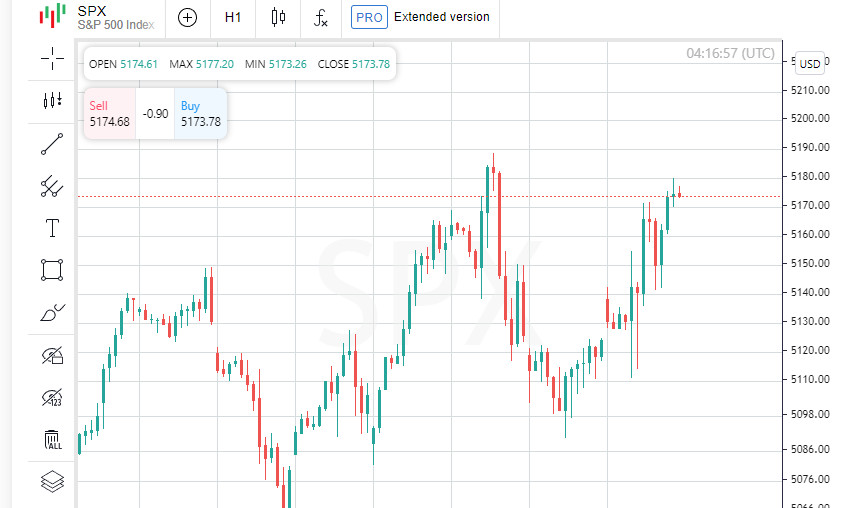
On Tuesday, the American stock markets showed significant growth: the S&P 500 index set a historic record, thanks to the rise in Oracle's stock price, while the consumer price data failed to undermine investors' expectations regarding the possible lowering of interest rates in the coming months.
Oracle's (ORCL.N) shares rose by 11.7% and reached an all-time high the day after the company published positive quarterly results and announced an upcoming joint statement with Nvidia (NVDA.O), a leader in the production of chips for artificial intelligence.
Nvidia's shares increased by 7.2%, and the semiconductor index (.SOX) rose by 2.1%, halting a two-day streak of declines.
The U.S. Department of Labor announced that the Consumer Price Index (CPI) jumped by 0.4% last month, following a 0.3% increase in January. Excluding volatile items such as food and energy resources, the core consumer prices also showed a growth of 0.4% in February, mirroring January's outcome.
Over the 12 months ending in February, the CPI rose by 3.2%, slightly exceeding the forecast of 3.1% after a 3.1% increase in January.
On Tuesday, the global stock index was on track to recover after two days of declines, stretching along with the yield on government bonds. This came following the publication of data confirming that inflation in the U.S. remained stable in February.
These details hint at the possibility that the Federal Reserve might continue to keep interest rates at a heightened level for longer than previously anticipated.
Investors have embraced the idea that the key question is not when the Federal Reserve will start to cut rates, but how aggressive these cuts will be. The question of whether this will happen in May, as many initially hoped, or be delayed until September, is not considered decisive by experts. Oliver Pursche, Senior Vice President and Advisor at Wealthspire Advisors in Westport, Connecticut, expressed this viewpoint.
According to the CME FedWatch Tool, traders currently estimate a 70% chance of the first interest rate cut occurring in June, slightly less than the previous estimate of 71% before the inflation report was published.
"An inflation rate exceeding expectations indicates consumer well-being and shows the economy's 'pricing power' that businesses are leveraging. Analysis of other economic indicators suggests that this is not having a negative impact," noted Rob Haoworth, a senior investment strategist at a bank's asset management division in Seattle.
The Dow Jones Industrial Average (.DJI) rose by 235.74 points, or 0.61%, reaching 39,005.4. The S&P 500 (.SPX) increased by 57.3 points, or 1.12%, to 5,175.24, while the Nasdaq Composite (.IXIC) grew by 246.36 points, or 1.54%, closing at 16,265.64.
The producer price index report is expected to be published at the end of this week. Boeing's (BA.N) shares fell by 4.3%. On Tuesday, Boeing informed its employees through an internal memo about the implementation of weekly compliance checks at each work site of the 737 production plant, as well as the introduction of additional equipment inspections with the aim of minimizing product quality issues.
The Federal Aviation Administration (FAA) of the U.S. imposed restrictions on Boeing's production following an incident where a panel peeled off in flight on a new Alaska Airlines 737 MAX 9 airplane on January 5th.
U.S. airlines also expressed concerns that their strategies for expanding transport capacity might be jeopardized due to delays in the delivery of airplanes from Boeing.
Shares of Southwest Airlines (LUV.N) fell by 14.9%.
Trading volume on U.S. exchanges reached 10.97 billion shares, compared with the usual average level of 12.07 billion over the last 20 sessions. On the New York Stock Exchange (NYSE), the number of advancing stocks exceeded the number of declining ones in a ratio of 1.28 to 1; on Nasdaq, the ratio was 1.20 to 1 in favor of declines.
The S&P 500 index recorded 48 new 52-week highs and showed no new lows; the Nasdaq Composite index registered 59 new highs and 118 new lows.
 English
English 
 Русский
Русский Bahasa Indonesia
Bahasa Indonesia Bahasa Malay
Bahasa Malay ไทย
ไทย Español
Español Deutsch
Deutsch Български
Български Français
Français Tiếng Việt
Tiếng Việt 中文
中文 বাংলা
বাংলা हिन्दी
हिन्दी Čeština
Čeština Українська
Українська Română
Română

